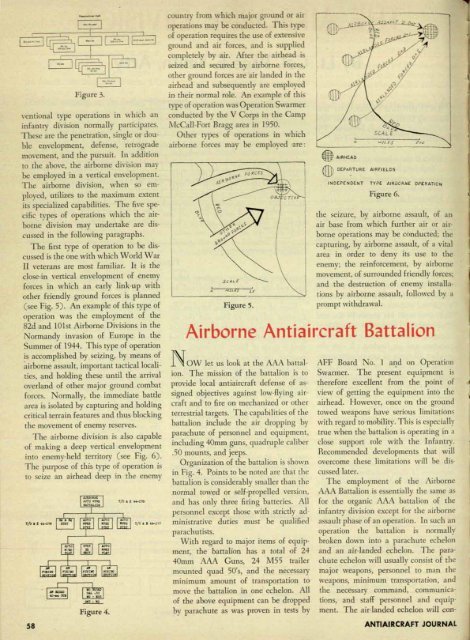July-August - Air Defense Artillery
July-August - Air Defense Artillery
July-August - Air Defense Artillery
Create successful ePaper yourself
Turn your PDF publications into a flip-book with our unique Google optimized e-Paper software.
Figure 3.<br />
ventional type operations in which an<br />
infantry division normally participates.<br />
These are the penetration, single or double<br />
envelopment, defense, retrograde<br />
movement, and the pursuit. In addition<br />
to the above, the airborne division may<br />
be employed in a vertical envelopment.<br />
The airborne division, when so employed,<br />
utilizes to the maximum extent<br />
its specialized capabilities. The five specific<br />
types of operations which the airborne<br />
division may undertake are discussed<br />
in the following paragraphs.<br />
The first type of operation to be discussed<br />
is the one with which \Vorld vVar<br />
II veterans are most familiar. It is the<br />
close-in vertical envelopment of enemy<br />
forces in which an early link-up with<br />
other friendly ground forces is planned<br />
(see Fig. 5). An example of this type of<br />
operation was the employment of the<br />
82d and 100st <strong>Air</strong>borne Divisions in the<br />
Normandy invasion of Europe in the<br />
Summer of 1944. This type of operation<br />
is accomplished by seizing, by means of<br />
airborne assault, important tacticallocalitics,<br />
and holding these until the arrival<br />
overland of other major ground combat<br />
forces. Normally, the immediate battle<br />
area is isolated by capturing and holding<br />
critical terrain features and thus blocking<br />
the movement of enemy reserves.<br />
The airborne division is also capable<br />
of making a deep vertical envelopment<br />
into enemy-held territory (see Fig. 6).<br />
The purpose of this type of operation is<br />
to seize an airhead deep in the enemy<br />
Figure 4.<br />
:/0 a I 44-211<br />
country from which major ground or air<br />
operations may be conducted. This type<br />
of operation requires the use of extensive<br />
ground and air forces, and is supplied<br />
completely by air. After the airhead is<br />
seized and secured bv airborne forces.<br />
other ground forces ar~ air landed in the<br />
airhead and subsequently are employed<br />
in their normal role. An example of this<br />
type of operation was Operation Swarmer<br />
conducted by the V Corps in the Camp<br />
1\ IcCall-Fort Bragg area in 1950.<br />
Other types of operations in which<br />
airborne forces may be employed are:<br />
Figure 5.<br />
NO\\' let us look at the AA1\ battalion.<br />
The mission of the battalion is to<br />
provide local antiaircraft defense of assigned<br />
objectives against low-Hying aircraft<br />
and to fire on mechanized or other<br />
terrestrial targets. The capabilities of the<br />
battalion include the air dropping by<br />
parachute of personnel and equipment,<br />
including 40mm guns, quadruple caliber<br />
.50 mounts, and jeeps.<br />
Organization of the battalion is shown<br />
in Fig. 4. Points to be noted are that the<br />
battalion is considerably smaller than the<br />
normal towed or self-propelled version,<br />
and has only three firing batteries. All<br />
personnel except those with strictly administrative<br />
duties must be qualified<br />
parachutists.<br />
\Vith regard to major items of equipment,<br />
the battalion has a total of 24<br />
40mm AAA Guns, 24 rvl55 trailer<br />
mounted quad 50's, and the necessary<br />
minimum amount of transportation to<br />
move the battalion in one echelon. All<br />
of the above equipment can be dropped<br />
by parachute as was proven in tests by<br />
~ AIRHEAD<br />
@ DEP:.RTURE AIRfiELDS<br />
INDEPE NDENT TY~E AIRtJORI/E OPERATIC"<br />
Figure 6.<br />
the seizure, by airborne assault, of an<br />
air base from which further air or airborne<br />
operations may be conducted; the<br />
capturing, by airborne assault, of a vital<br />
area in order to deny its use to the<br />
enemy; the reinforcement, by airborne<br />
movement, of surrounded friendly forces;<br />
and the destruction of enemy installations<br />
by airborne assault, followed by a<br />
prompt withdrawal.<br />
<strong>Air</strong>borne Antiaircraft Battalion<br />
AFF Board No. 1 a~d on Operation<br />
Swanner. The present equipment is<br />
therefore excellent from the point of<br />
view of getting the equipment into the<br />
airhead. However, once on the ground<br />
towed weapons have serious limitations<br />
with regard to mobil!ty. This is especially<br />
true when the battalion is operating in a<br />
close support role with the Infantry.<br />
Recommended developments that will<br />
overcome these limitations will be discussed<br />
later.<br />
The employment of the <strong>Air</strong>borne<br />
AAA Battalion is essentially the same as<br />
for the organic AAA battalion of the<br />
infantry division except for the airborne<br />
assault phase of an operation. In such an<br />
operation the battalion is normally<br />
broken down into a parachute echelon<br />
and an air-landed echelon. The parachute<br />
echelon will usually consist of the<br />
major weapons, personnel to man the<br />
weapons, minimum transportation, and<br />
the necessary command, communications,<br />
and staff personnel and equipment.<br />
The air-landed echelon will con-<br />
58 ANTIAIRCRAFT JOURNAL<br />
, I<br />
•
















